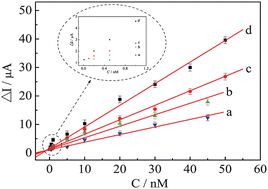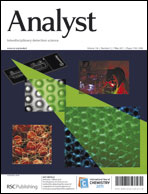In this work, a label-free electrochemical aptamer-based sensor (aptasensor) was constructed on account of the direct immobilization of redox probes on an electrode surface. For this proposed aptasensor, a gold nanoparticles (AuNPs)-coated electrode was firstly modified with redox probes–nickel hexacyanoferrates nanoparticles (NiHCFNPs) through chemisorption and electrostatic adsorption. Then, platinum–gold alloy nanoparticles (Pt–AuNPs) and horseradish peroxidase (HRP) were respectively assembled onto the modified electrode surface, which formed the multilayer films for amplifying the electrochemical signal of NiHCFNPs and immobilizing thiolated thrombin aptamers (TBAs). In the presence of target thrombin, the TBA on the multilayer could catch the thrombin onto the electrode surface, which resulted in a barrier for electro-transfer, leading to the decrease of the electrochemical signal of NiHCFNPs amplified by the Pt–AuNPs and HRP toward H2O2. The proposed method avoided the redox probes labeling process, increased the amount of redox probes, and further amplified the electrochemical signal. Thus, the approach showed a high sensitivity and a wider linearity to thrombin in the range between 0.01 nM and 50 nM with a detection limit of 6.3 pM.

You have access to this article
 Please wait while we load your content...
Something went wrong. Try again?
Please wait while we load your content...
Something went wrong. Try again?


 Please wait while we load your content...
Please wait while we load your content...